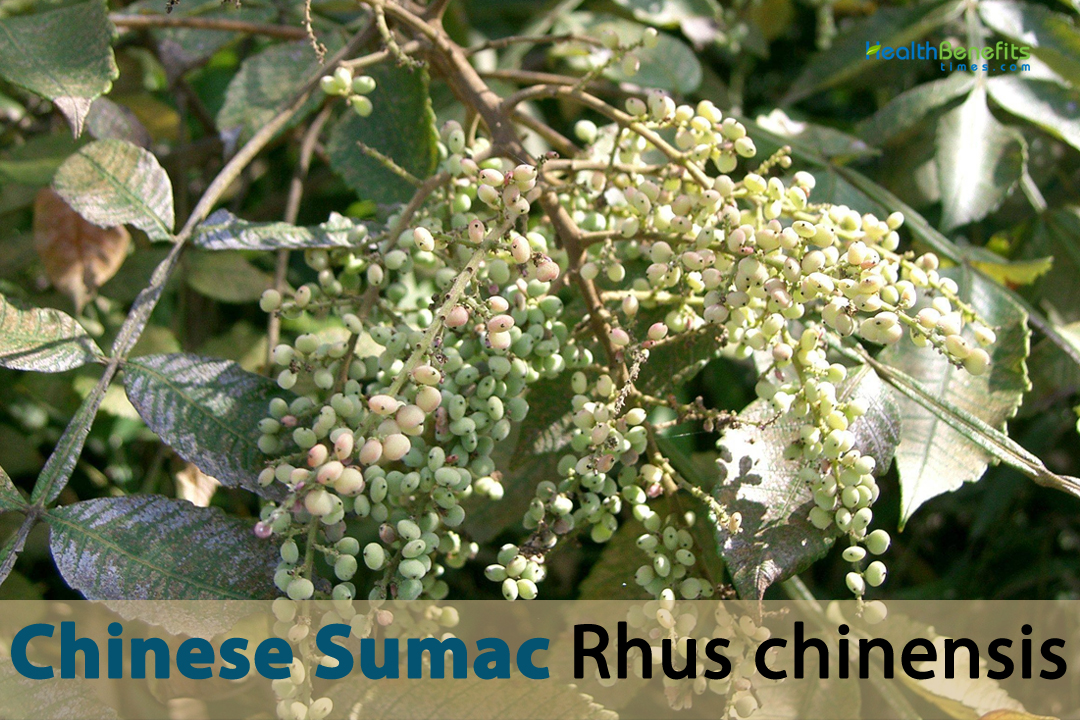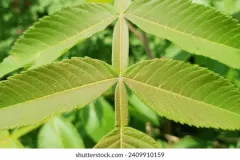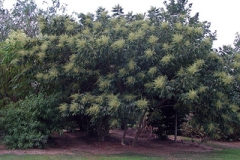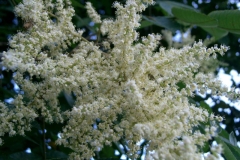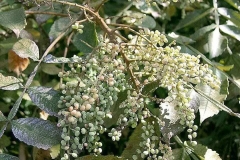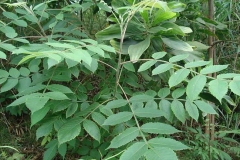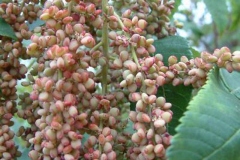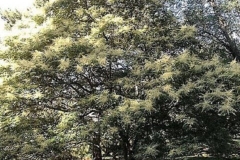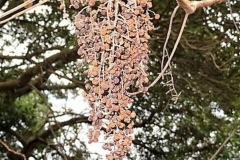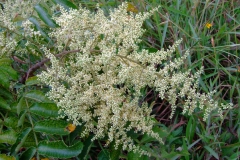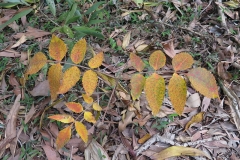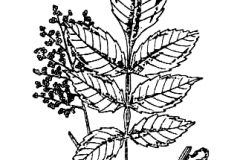| Chinese Sumac Quick Facts | ||
|---|---|---|
| Name: | Chinese Sumac | |
| Scientific Name: | Rhus chinensis | |
| Origin | Himalayas, from Kashmir to Bhutan, NE India, Ceylon, Burma, east to China, Korea and Japan | |
| Colors | Reddish-orange to yellow at maturity | |
| Shapes | Tiny, rounded, crimson drupes with a diameter of 4-5 mm that are grouped | |
| Taste | Sour, Astringent | |
| Health benefits | Treat hemoptysis, inflammations, laryngitis, snakebite, stomachaches, traumatic fractures, coughs, diarrhea, fever, jaundice, malaria, and rheumatism | |
| Name | Chinese Sumac |
|---|---|
| Scientific Name | Rhus chinensis |
| Native | Himalayas, from Kashmir to Bhutan, NE India, Ceylon, Burma, east to China, Korea and Japan. It is grown abundantly in Manipur, North-East India |
| Common Names | Chinese gall, Chinese sumac, Nutgall, Nutgall tree, Red gall nut tree, nutgal sumac, Galls of the Chinese Sumac |
| Name in Other Languages | Arabic: Samaq siniun (سماق صيني), Sumāq Ṣīnī (سماق صيني) Assamese: Naga tenga (নগা টেঙা), Noga-tenga Belarusian: Sumach kitajski (сумах кітайскі) Chinese: Wu bei zi (五倍子), Wǔbèizǐ miáo (五倍子苗), De ěr cǎo (tián jī huáng)(地耳草(田基黄), Bīn yán fū mù (yán fū mù) (滨盐肤木(盐肤木), Yán fū yè (盐肤叶), Yán fū zi (盐肤子), Yán fū mù (盐肤木), Yán fū mùpí (盐肤木皮) Czech: Škumpa čínská Dutch: Chinese Sumak English: Chinese gall, Chinese sumac, Nutgall, Nutgall tree, Red gall nut tree, nutgal sumac Finnish: Kiinanpihkasumakki French: Sumac de Chine German: Gallen-Sumach, Chinesischer Sumach Hindi: Tatri, Chīnī sumāk (चीनी सुमाक) Italian: Sommacco cinese Japanese: Nurude (ヌルデ),Urushinoki (ウルシノキ) Kannada: Dieng-sohma, Sabma Korean: Bulk na mu, bulgnamu (붉나무), Otnamu (옻나무) Manipuri: Heimang (ꯍꯩꯃꯥꯡ) Mizo: Khawmhma Nepali: Bhaki amilo (भकिअमिलो), Chuk Amilo (चुक अमिलो), Dudhe Bhalaayo (दुधे भलायो), Bhangil (भङ्गिल), Bhakmilō (भक्मिलो) Norwegian: Kinesisk sumac Persian: راس چینی Polish: Sumak chiński Portuguese: Falsa-aroeira, sumagre-da-China, árvore-do-sal, Sumagre chinês Russian: Sumakh Kitayskiy (Сумах китайский) Spanish: Zumaque Chino Swedish: Kinesiskt sumak Tangkhul: Khamkhuithei Thai: S̄̂m p̄hd (ส้มผด), Sū mæk cīn (ซูแมคจีน) Turkish: Çin sumak Upper Sorbian: Chinski sumac Vietnamese: Cây gắm |
| Plant Growth Habit | Deciduous, upright, spreading, often multi-branched shrub or small tree |
| Growing Climates | Lowland, hills, mountains, forests, forests along streams, thickets, forest edges, grasslands, valleys, stream banks |
| Soil | Grow in sandy, loamy, or clay soils. It prefers a soil pH that is slightly acidic to neutral. Good drainage is important to prevent root rot |
| Plant Size | 5 to 10 meters (16 to 33 feet) |
| Root | Extensive root system |
| Stem | Woody, erect, glabrous to pubescent, branching, can reach up to 6 meters in height |
| Leaf | Leaves are between 15 and 30 centimeters in length and are pinnately complex |
| Flowering season | August-September |
| Pollinators | Bees, butterflies |
| Flower | Little, greenish-yellow blooms on the shrub are produced in dense panicles |
| Fruit Shape & Size | Tiny, rounded, crimson drupes with a diameter of 4-5 mm that are grouped together |
| Fruit Color | Reddish-orange to yellow at maturity |
| Fruit Size | About 16.23 ± 2.66 mg |
| Taste | Sour, Astringent |
| Plant Parts Used | Bark, Stem, flower, Fruits, leaves, seeds and roots |
| Propagation | By seeds |
| Season | October |
| Companion Plants |
|
| Precautions |
|
Plant Description
Chinese Sumac is a deciduous shrub or small tree that is erect, spreading, and frequently has several branches. It normally reaches a height of 5 to 10 meters (16 to 33 feet), though under the correct circumstances, some individuals can reach as high as 15 meters (49 feet). During the growing season, the growth rate is moderate, averaging a few centimeters each month. The plant spreads by suckers and has a vast root system; it is not known to be very problematic and frequently forms thickets. When planting close to pavement or buildings, it is best to take potential root spread into account. The plant can be found growing in grasslands, valleys, hills, mountains, woods, thickets, forest borders, and forests near streams. The plant can thrive in clay, sandy soils, or loamy soils. It favors slightly acidic soil pH above neutral pH. Root rot can be avoided with proper drainage.
Stem
As the plant ages, the sturdy stems may take on a rough, grayish bark. Younger stems are smoother to the touch and may have a reddish hue.
Leaves
The leaves are between 15 and 30 centimeters in length and are pinnately complex. Each leaf is made up of seven to thirteen serrated leaflets that range in shape from ovate to lanceolate. The plant’s aesthetic appeal is increased by the leaves’ propensity to change to a brilliant crimson or orange in the fall.
Flower
Little, greenish-yellow blooms on the shrub are produced in dense panicles. These panicles bloom in late spring or early summer and can grow up to 20 cm in length. Though not very spectacular, the flowers do draw pollinators like bees.
Fruit
After flowering, Chinese Sumac produces tiny, rounded, crimson drupes with a diameter of 4-5 mm that are grouped together and have a berry-like appearance. These fruits attract birds and can stay on the tree well into the winter, giving wildlife something to eat.
Caring Chinese Sumac
Soil Preference
The soil type does not matter to Chinese sumac; it can thrive in clay, loamy, or sandy soils. It favors slightly acidic soil pH above neutral pH. Root rot can be avoided with proper drainage.
Watering
When the top inch or two of soil feels dry to the touch, Chinese sumac needs to be watered. Although watering frequency can vary based on the environment and season, this is usually done every 1-2 weeks. Water the soil until it is saturated, then let the extra water runoff. Refrain from overwatering as this may lead to plant root rot.
Sunlight
Chinese sumac is a sun-loving plant that grows best in areas with bright, full sun. Chinese sumac grows best in areas with 6–8 hours of sunshine every day during the growing season. It can withstand up to 10–12 hours of sunlight every day during the warmer months, but direct, bright afternoon sunlight is not something it should be exposed to. Chinese sumac needs at least 4-6 hours of direct sunlight per day in colder areas.
Pruning
Pruning Chinese sumac should be done in the early spring or late winter. For this species, light, selective pruning is necessary, with an emphasis on removing weak growth and any diseased, damaged, or dead wood. This will support the promotion of a generally healthy form. In addition, bushier growth and more flowers can be promoted by pruning back part of the longer stems to a higher bud.
Propagation
One can accomplish propagation by layering, cuttings, or seeds. While cuttings from semi-hardwood growth should be taken in the summer, seeds need to be stratified before being sown.
Health & Safety
Like other members of the Anacardiaceae family, certain sections of Chinese samba may contain substances that irritate sensitive people’s skin or trigger allergic reactions. When working with the plant, gloves are advised. When consumed, the plant is not known to be harmful to people, dogs, or cats.
Pests and Problems
Aphids, especially those that create the valuable galls, can affect Chinese scallions. Mites and scale insects are two other possible pests. For control, one can employ natural predators or pesticides. Although the plant is typically disease-resistant, it may have root rot if planted in soil that does not drain well. A healthy plant requires careful cultural techniques and routine monitoring.
Traditional medicinal uses of Chinese Sumac
| SN | Plant Parts | Medicinal Use |
| 1. | Leaves | Hemostasis, inflammations, laryngitis, stomachaches, traumatic fractures, spermatorrhea, snake bite, antitussive, diarrhea, and depurative properties can all be stimulated. |
| 2. | Fruits | Hepatitis, jaundice, diarrhea, dysentery, and colonic |
| 3. | Seeds | Rheumatism, diarrhea, fever, jaundice, hepatitis, and malaria |
| 4. | Roots | snake bites, spermatorrhea, malaria, antitussives, anasarca therapies, jaundice, and diarrhea |
| 5. | Galls | Diarrhea, diabetes mellitus, burns, hemorrhoids, oral illnesses, fever, malaria, inflammation, toxicosis, sore, skin infections, rectal and intestine cancer, chronic bloody cough, spontaneous sweating, urorrhea, bloody sputum, and so on |
Traditional Uses
- The decoction of the leaves and roots is used to treat hemoptysis, inflammations, laryngitis, snakebite, stomachaches, and traumatic fractures. It also stimulates blood circulation.
- Fruit is used to alleviate colic.
- Stem bark is astringent and anthelmintic.
- Coughs, diarrhea, fever, jaundice, malaria, and rheumatism can all be treated with seed.
- Bark from trees is cholagogue.
- Because of their styptic and astringent qualities, they are taken internally to cure ailments including bleeding and diarrhea.
- They are often included in multi herbal prescriptions for the treatment of diabetes mellitus.
- It is used to treat urorrhea, bloody sputum, spontaneous sweating, nocturnal sweats, chronic diarrhea, and persistent bloody cough.
- It is utilized externally to hemorrhoids, burns, traumatic injury hemorrhage, and ulcers in the mouth.
- In traditional Chinese medicine, Chinese galls are used to treat dysentery, diarrhea, coughs, night sweats, and to regulate uterine and intestinal bleeding.
- Galls are gathered and used in traditional medicine and tannin manufacture for the leather industry.
- In Manipur, bark is used to treat diarrhea and fruits and leaves to treat colic.
Other Uses
- Blue dye is made from insect galls on the plant; it can also be used as an ink.
- The leaves are rich in tannin. They can be collected as they fall in the autumn and used as a brown dye or as a mordant.
- The seeds are removed to yield an oil. When left to stand, it takes on the consistency of tallow and is used to produce candles. These produce a strong smoke, but they burn brightly.
- The plant’s extract is used as a skin conditioner in commercial cosmetic preparations; moreover, an extract of the galls the plant produces is utilized in the same capacity.
- Commercial cosmetic products use an extract of the leaves and stem as an astringent, emollient, antibacterial, antifoaming agent, and hair conditioner.
- The wood is soft and is not used.
- An extract of the leaves and stems is used as a skin protector in commercial cosmetic preparations.
- An extract of the root is used as an emollient in commercial cosmetic preparations.
References:
https://www.itis.gov/servlet/SingleRpt/SingleRpt?search_topic=TSN&search_value=506464#null
https://npgsweb.ars-grin.gov/gringlobal/taxon/taxonomydetail?id=31679
https://pfaf.org/user/Plant.aspx?LatinName=Rhus+chinensis
https://www.cabidigitallibrary.org/doi/10.1079/cabicompendium.47391
https://gd.eppo.int/taxon/RHUCH
https://www.flowersofindia.net/catalog/slides/Chinese%20Sumac.html
https://edis.ifas.ufl.edu/publication/ST567
https://indiabiodiversity.org/species/show/279835
https://en.wikipedia.org/wiki/Rhus_chinensis
https://tropical.theferns.info/viewtropical.php?id=Rhus+chinensis
https://plants.sc.egov.usda.gov/home/plantProfile?symbol=RHCH9


